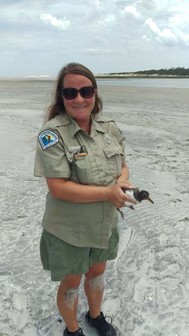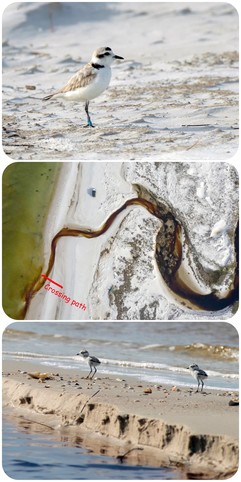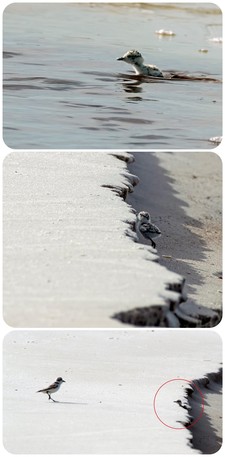Shorebird Stewardship Training:
May 2, 1pm: St. Johns County stewardship training, St. Augustine Alligator Farm Zoological Park, hosted by Audubon Florida
May 11, 9am: Pinellas County Municipal Beach stewardship training
(covers Sand Key, Clearwater Point, Indian Shores, St. Pete Beach)
Indian Shores City Hall, 4th floor; hosted by Audubon Florida
Events:
May 9: Shorebird Walk at Matanzas Inlet
May 11: World Migratory Bird Day
May 23: A Day in the Life of A Seabird Biologist
Reminders:
May 13-19: The May count window for the Breeding Bird Protocol. Whenever possible, weekly surveys are preferred for routes with active nesting; it helps capture information about peak counts.
May 24-27: Memorial Day Weekend! Shorebirds and seabirds nesting along the coast need more support during busy holiday weekends. Can you help? If so, contact a local Stewardship Coordinator.

Partner Spotlight: Allison Conboy of the Timucuan Shorebird Partnership
As a Park Services Specialist, Allison Conboy leads the imperiled coastal nesting species programs that include sea turtles, diamondback terrapins, and shorebirds at Talbot Islands State Parks. Originally from Atlanta, GA, Allison began working seasonally at Talbot Islands in 2011 after completing her M.S. from Trinity College in Dublin, Ireland. In the same year, she was hired into her current role and has been the on-site shorebird manager for eight miles of protected shoreline ever since.
In her role, Allison coordinates year-round weekly surveys of shorebirds at the park. She recruits college students to assist with pre-season posting of nesting areas. During the breeding season, she also organizes intensive daily monitoring of nesting shorebirds and stewarding during busy holidays and weekends. Talbot Island State Parks hosts breeding American oystercatchers, black skimmers, gull-billed terns, least terns, willets, and Wilson’s plovers. However, it is the stealthy, sentinel Wilson’s plover that Allison calls favorite.
When not coordinating shorebird conservation, Allison helps manage the park lands and visitors. She recruits volunteers, partners with a multitude of organizations, designs interpretive programs, conducts outreach and develops educational publications, manages cultural sites and habitat restoration, and performs prescribed fires and exotic invasive plant removal. In every aspect of her work, she is happy to conserve some of the last wild lands along the northeast Florida coast.
With a life-long passion for the outdoors and family, Allison is proud to safeguard imperiled coastal species and lands so that her two children can appreciate the wild side of life. She and her husband, Jonathan, share their love of outdoors with their children through hiking, paddling, camping, fishing, trail riding, fossil hunting, and star gazing together. She applies this same enthusiasm when educating beachgoers about the importance of birds in coastal ecosystems. She believes that increasing awareness and understanding of coastal lands and animals is crucial to building a movement of conservationists. In fact, if anyone knows David Attenborough and the Planet Earth crew, let us know. Allison would like to see a documentary on the incredible shorebirds of Florida that features the ways in which we can share the shore.
Thank you, Allison, for your dedication to the wild lands and animals at Talbot Islands State Parks and beyond. Your role in the Timucuan Shorebird Partnership is deeply appreciated! We look forward to partnering during another breeding season at the park.
|

Exporting FSD Data for Google Earth
Last year, we introduced KMZ data exports so that anyone can explore their data in Google Earth. This year, we improved the KMZ export! When you export a KMZ from Custom Search, the data are now organized by site type and species. This means you can use site type and species to filter what data are displayed. Just go to the Places pane on the left side of your Google Earth window to check it out. With the new KMZ export, you have more control over what you see displayed in Google Earth!

Intrepid Snowy Plover Chicks Brave New Waters
Long-time shorebird and sea turtle monitor, Barbara Eells, could hardly believe her eyes when conducting a routine survey in the eastern panhandle in April. In disbelief, she requested confirmation of the sighting from fellow sea turtle volunteer, Bill Fauth. Fortunately, Bill had his camera ready to provide photo evidence.
What the monitoring duo saw was real. A pair of snowy plover chicks swimming across a stream. In the wake of Hurricane Michael and consistent heavy rains, new streams are flowing into the gulf. For coastal wildlife, like shorebirds, this means navigating new terrain.
At first glance, crossing a steam might not seem remarkable. Considering that young snowy plover chicks are compared to cotton balls walking on q-tips, it is a significant feat for these birds to cross a stream that is 10-15 feet wide and a foot deep.
|

Snowy plovers are well-known for traveling long distances to forage and this family is no exception. Since the initial sighting, Barbara has seen this and another snowy plover family consistently cross multiple streams to forage.
In the sequence of photos, the male adult plover flies to the opposite bank and calls to the chicks. To avoid getting caught in the swift (to them) current, the shorebird chicks quickly swam across the stream, making the dash in about three seconds. After the stream, they successfully jumped up the escarpment and continued foraging together.
The impacts of Hurricane Michael continue to ripple across the panhandle. Coastal communities are working hard to rebuild and Florida's wildlife is adapting accordingly. As our panhandle FSA partners continue to restore life as normal, we thank you for your dedication to ensuring shorebirds have space to do the same.
|
|